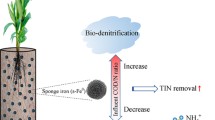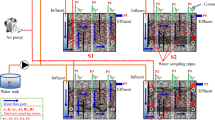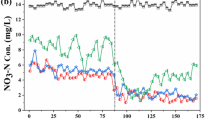Abstract
Purpose
Nitrogen reduction in a eutrophic river canal using bioactive multilayer capping (BMC) with biozeolite and sand was examined through laboratory incubation experiments over 121 days.
Materials and methods
Biofilm formation on zeolite was cultivated by a mixed culture containing isolated heterotrophic nitrifiers (Bacillus sp.) and aerobic denitrifiers (Acinetobacter sp.). Two combination methods of biozeolite and sand (with two grain sizes) were used in the experiments: combination I had biozeolite on top of sand, while combination II had sand on top of biozeolite.
Results and discussion
BMC not only completely inhibited ammonium release from sediment but also reduced total nitrogen (TN) in the overlying water and sediment. On day 24, the reduction efficiencies of TN in overlying water by BMC were 60–82 %. After day 24, the long-term effectiveness of nitrogen reduction by BMC using combination II was found to be significantly better than that using combination I. Fine sand used for BMC was found to be superior to coarse sand in nitrogen reduction. Fine sand on the upper layer could strengthen biological denitrification of the biozeolite layer. The optimal BMC could reduce the amount of biozeolite and thus the costs of the technique. The TN reduction efficiency of sediment by the optimal BMC was up to 13 %.
Conclusions
BMC with biozeolite under the fine sand was found to be a feasible technique to reduce N in a eutrophic river canal.






Similar content being viewed by others
References
Azcue JM, Zeman AJ, Mudroch A, Rosa F, Patterson T (1998) Assessment of sediment and porewater after one year of subaqueous capping of contaminated sediments in Hamilton Harbour, Canada. Water Sci Technol 37:323–329
Berg U, Neumann T, Donnert D, Nüesch R, Stüben D (2004) Sediment capping in eutrophic lakes—efficiency of undisturbed calcite barriers to immobilize phosphorus. Appl Geochem 19:1759–1771
Ding W, Zhu L, Xu J, Feng LJ, Xu XY (2011) Progress of researches on aerobic denitrifiers and their application in bioremediation. Chin J Appl Environ Biol 17:923–929
Du GC, Geng JJ, Chen J, Lun SY (2003) Mixed culture of nitrifying bacteria and denitrifying bacteria for simultaneous nitrification and denitrification. World J Microb Biot 19:433–437
Förstner U, Apitz SE (2007) Sediment remediation: U.S. focus on capping and monitored natural recovery. Fourth International Battle Conference on Remediation of Contaminated sediments. J Soils Sediments 7:351–358
Ge SJ, Peng YZ, Wang SY, Lu CC, Cao X, Zhu YP (2012) Nitrite accumulation under constant temperature in anoxic denitrification process: the effects of carbon sources and COD/NO3–N. Bioresource Technol 114:137–143
Gibbs M, Özkundakci D (2011) Effects of a modified zeolite on P and N processes and fluxes across the lake sediment–water interface using core incubations. Hydrobiologia 661:21–35
Go J, Lampert DJ, Stegemann JA, Reible DD (2009) Predicting contaminant fate and transport in sediment caps: mathematical modeling approaches. Appl Geochem 24:1347–1353
Gustavson KE, Burton GA, Francingues NR, Reible DD, Vorhees DJ, Wolfe JR (2008) Evaluating the effetiveness of contaminated-sediment dredging. Environ Sci Technol 42:5042–5047
Hajaya MG, Pavlastathis SG (2012) Fate and effect of benzalkonium chlorides in a continuous-flow biological nitrogen removal system treating poultry processing wastewater. Biosourc Technol 118:73–81
Huang TL, Xu JL, Cai DJ (2011) Efficiency of active barriers attaching biofilm as sediment capping to eliminate the internal nitrogen in eutrophic lake and canal. J Environ Sci-China 23:738–743
Huang TL, Zhou ZM, Xu JL, Dong YH, Wang G (2012) Biozeolite capping for reducing nitrogen load of the Ancient Canal in Yangzhou City. Water Sci Technol 66:336–344
Jacobs PH, Förstner U (1999) Concept of subaqueous capping of contaminated sediment with active barrier system (ABS) using natural and modified zeolite. Water Res 33:2083–2087
Kim G, Jung W (2010) Role of sand capping in phosphorus release from sediment. KSCE J Civ Eng 14:815–821
Kim M, Jeong SY, Yoon SJ, Cho SJ, Kim YH, Kim MJ, Ryu EY, Lee SJ (2008) Aerobic denitrification of Pseudomonas putida AD-21 at different C/N Ratios. J Biosci Bioeng 106:498–502
Lin JW, Zhan YH, Zhu ZL (2011) Evaluation of sediment capping with active barrier systems (ABS) using calcite zeolite mixtures to simultaneously manage phosphorus and ammonium release. Sci Total Environ 409:638–646
Lampert DJ, Reible D (2009) An analytical modeling approach for evaluation of capping of contaminated sediments. Soil Sediment Contam 18:470–488
Meis S, Spears BM, Maberly SC, O’Malley MB, Perkins RG (2012) Sediment amendment with phoslock® in Clatto reservoir (Dundee, UK): investigating changes in sediment elemental composition and phosphorus fractionation. J Environ Manage 93:185–193
Özkundakci D, Hamilton DP, Gibbs MM (2011) Hypolimnetic phosphorus and nitrogen dynamics in a small, eutrophic lake with a seasonally anoxic hypolimnion. Hydrobiologia 661:5–20
Perkins RG, Underwood GJC (2002) Partial recovery of a eutrophic reservoir through managed phosphorus limitation and unmanaged macrophyte growth. Hydrobiologia 481:75–87
Shin EW, Han JS (2004) Phosphate adsorption on aluminium-impregnated mesoporous silicates: surface structure and behaviour of adsorbents. Environ Sci Technol 38:912–917
Sun SJ, Wang L, Huang SL, Tu T, Sun HW (2011) The effect of capping with natural and modified zeolite on the release of phosphorus and organic contaminants from river sediment. Front Chem Sci Eng 5:308–313
Tang XQ, Wu M, Yang WJ, Yin W, Jin F, Ye M, Currie N, Scholz M (2012) Ecological strategy for eutrophication control. Water Air Soil Poll 223:723–737
Zhang XY, Wu ZC, Wang ZW, Zhou Q, Yang DH (2010) Adsorption characteristics of ammonium ions by natural clinoptilolite powder. Chin Environ Sci 30:609–614
Acknowledgments
This work was supported by the program of International S & T Cooperation (grant no. 2010 DFA 94550), the National Natural Science Fund of China (grant no. 50830303), National Science and Technology Pillar Program (grant no. 2012BAC04B02), Shaanxi Provincial Science & Technology Innovative Project (grant no. 2011KTCG03-07), and Program for Changjiang Scholars and Innovative Research Team in University (grant no. IRT0853).
Author information
Authors and Affiliations
Corresponding author
Additional information
Responsible editor: Gijs D. Breedveld
Rights and permissions
About this article
Cite this article
Huang, T., Zhou, Z., Su, J. et al. Nitrogen reduction in a eutrophic river canal using bioactive multilayer capping (BMC) with biozeolite and sand. J Soils Sediments 13, 1309–1317 (2013). https://doi.org/10.1007/s11368-013-0703-5
Received:
Accepted:
Published:
Issue Date:
DOI: https://doi.org/10.1007/s11368-013-0703-5




